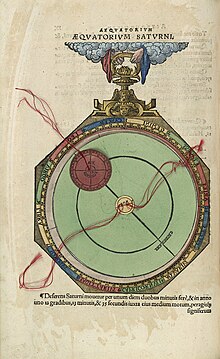Equatorium

The equatorium ( Latin : equation device) is a device for the mechanical-geometric determination of the planetary positions in the zodiac on the basis of Ptolemy's geocentric planetary system .
description
Ancient astronomy differentiated between fixed stars and moving stars (planets): Moon , Mercury , Venus , Sun , Mars , Jupiter and Saturn . While the fixed stars do not change their position among each other, the planets carry out complicated movements against the background of the starry sky. The calculation of the movements of the sun and moon was especially important for calculating time and for creating a calendar . The constellation of the other planets was indispensable for the creation of the horoscope .
Around 150 AD, Claudius Ptolemy summarized the ancient knowledge of planetary movements and developed a method of calculating their positions for any period of time. The prerequisites of his system, which were valid up to the early modern era, were the assumptions that the earth was immovable in the center of the universe and that every movement in the sky could be traced back to circular movements at a constant speed .
Since Ptolemy derived the motion of a planet only from the uniform circular motion ( epicyclic theory ), namely with its motion on an upward circle, the epicyclic, which is not fixed in space but moves on a second circle, the carrier circle or deferent (picture left) the calculation is very complicated.
In order to get around these extremely complicated and error-prone calculations with several variables, Campanus of Novara proposed a device in the middle of the 13th century that represents the Ptolemaic planetary theory in two-dimensional models made of movable disks. Such devices are known from the 14th to 16th centuries as parchment, paper, wood or metal instruments, the latter also in connection with clockworks .
The devices for displaying the planetary movements with small disks on large disks were very popular. The prescriptions for their preparation are numerous; the required starting angles for a certain day were also given. Such work has been handed down since the 14th century.
See also
literature
- Petrus Apian : Astronomicum caesareum ; Library, University of Vienna
- Henry C. King, John R. Millburn: Geared to the stars . Toronto 1978, ISBN 0-80202-312-6 and ISBN 0-85274-399-8 , pp. 15f.
- Henry Michel: measuring over time and space . Chr.Belser Verlag Stuttgart 1965, pp. 130f.
- Ernst Zinner : German and Dutch astronomical instruments of the 11th - 18th centuries. CH Beck'sche Verlagsbuchhandlung, Munich 1956, p. 31f.
Web links
- UNI Frankfurt: Museum; Astronomy II (selection of images)
- Zoonar: Equatorium (image)
Individual evidence
- ↑ a b Reinhard Glasemann: Earth, Sun, Moon & Stars ; in writings of the Historisches Museum Frankfurt / M. 1999, No. 20; ISBN 3-7829-0504-0 .
- ↑ Georg-August University of Göttingen: Schöner, Johann
- ^ Museum of the History of Science: Astrolabe and Equatorium, Southern France or Northern Italy, Late 15th Century
- ^ Franz Adrian Dreier: Winkelmessinstrument , Kunstgewerbemuseum Berlin 1979, P. 90f

